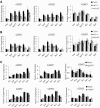Ethylene-Regulated Glutamate Dehydrogenase Fine-Tunes Metabolism during Anoxia-Reoxygenation
- PMID: 27677986
- PMCID: PMC5100772
- DOI: 10.1104/pp.16.00985
Ethylene-Regulated Glutamate Dehydrogenase Fine-Tunes Metabolism during Anoxia-Reoxygenation
Abstract
Ethylene is an essential hormone in plants that is involved in low-oxygen and reoxygenation responses. As a key transcription factor in ethylene signaling, ETHYLENE INSENSITIVE3 (EIN3) activates targets that trigger various responses. However, most of these targets are still poorly characterized. Through analyses of our microarray data and the published Arabidopsis (Arabidopsis thaliana) EIN3 chromatin immunoprecipitation sequencing data set, we inferred the putative targets of EIN3 during anoxia-reoxygenation. Among them, GDH2, which encodes one subunit of glutamate dehydrogenase (GDH), was chosen for further studies for its role in tricarboxylic acid cycle replenishment. We demonstrated that both GDH1 and GDH2 are induced during anoxia and reoxygenation and that this induction is mediated via ethylene signaling. In addition, the results of enzymatic assays showed that the level of GDH during anoxia-reoxygenation decreased in the ethylene-insensitive mutants ein2-5 and ein3eil1 Global metabolite analysis indicated that the deamination activity of GDH might regenerate 2-oxoglutarate, which is a cosubstrate that facilitates the breakdown of alanine by alanine aminotransferase when reoxygenation occurs. Moreover, ineffective tricarboxylic acid cycle replenishment, disturbed carbohydrate metabolism, reduced phytosterol biosynthesis, and delayed energy regeneration were found in gdh1gdh2 and ethylene mutants during reoxygenation. Taken together, these data illustrate the essential role of EIN3-regulated GDH activity in metabolic adjustment during anoxia-reoxygenation.
© 2016 American Society of Plant Biologists. All Rights Reserved.
Figures









Similar articles
-
Ethylene plays an essential role in the recovery of Arabidopsis during post-anaerobiosis reoxygenation.Plant Cell Environ. 2014 Oct;37(10):2391-405. doi: 10.1111/pce.12292. Epub 2014 Mar 12. Plant Cell Environ. 2014. PMID: 24506560
-
NAD(H)-dependent glutamate dehydrogenase is essential for the survival of Arabidopsis thaliana during dark-induced carbon starvation.J Exp Bot. 2008;59(3):667-80. doi: 10.1093/jxb/erm340. Epub 2008 Feb 21. J Exp Bot. 2008. PMID: 18296429
-
Differential regulation of EIN3 stability by glucose and ethylene signalling in plants.Nature. 2003 Oct 2;425(6957):521-5. doi: 10.1038/nature01984. Nature. 2003. PMID: 14523448
-
The role of ethylene in metabolic acclimations to low oxygen.New Phytol. 2021 Jan;229(1):64-70. doi: 10.1111/nph.16378. Epub 2020 Jan 18. New Phytol. 2021. PMID: 31856295 Free PMC article. Review.
-
Oxygen sensing and signaling.Annu Rev Plant Biol. 2015;66:345-67. doi: 10.1146/annurev-arplant-043014-114813. Epub 2015 Jan 12. Annu Rev Plant Biol. 2015. PMID: 25580837 Review.
Cited by
-
Plant Life with and without Oxygen: A Metabolomics Approach.Int J Mol Sci. 2023 Nov 12;24(22):16222. doi: 10.3390/ijms242216222. Int J Mol Sci. 2023. PMID: 38003412 Free PMC article. Review.
-
Multi-stress resilience in plants recovering from submergence.Plant Biotechnol J. 2023 Mar;21(3):466-481. doi: 10.1111/pbi.13944. Epub 2022 Nov 14. Plant Biotechnol J. 2023. PMID: 36217562 Free PMC article. Review.
-
Cloning and Bioinformatics Analysis of GhArfGAP in Cotton (Gossypium hirsutum) Boll Abscission Layer With Ethylene Treatment.Front Plant Sci. 2022 Jun 24;13:841161. doi: 10.3389/fpls.2022.841161. eCollection 2022. Front Plant Sci. 2022. PMID: 35812965 Free PMC article.
-
Drought and Subsequent Soil Flooding Affect the Growth and Metabolism of Savoy Cabbage.Int J Mol Sci. 2021 Dec 10;22(24):13307. doi: 10.3390/ijms222413307. Int J Mol Sci. 2021. PMID: 34948111 Free PMC article.
-
Salt Stress Tolerance in Casuarina glauca: Insights from the Branchlets Transcriptome.Plants (Basel). 2022 Nov 1;11(21):2942. doi: 10.3390/plants11212942. Plants (Basel). 2022. PMID: 36365395 Free PMC article.
References
-
- Alonso JM, Hirayama T, Roman G, Nourizadeh S, Ecker JR (1999) EIN2, a bifunctional transducer of ethylene and stress responses in Arabidopsis. Science 284: 2148–2152 - PubMed
-
- Bieniawska Z, Barratt DHP, Garlick AP, Thole V, Kruger NJ, Martin C, Zrenner R, Smith AM (2007) Analysis of the sucrose synthase gene family in Arabidopsis. Plant J 49: 810–828 - PubMed
MeSH terms
Substances
LinkOut - more resources
Full Text Sources
Other Literature Sources
Molecular Biology Databases
Research Materials

